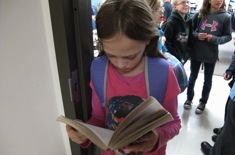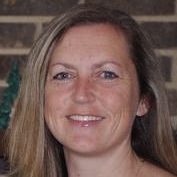Maggie was in first grade when I began to work with her in reading support. In those beginning days, she sat beside me at the table as I tried to get to know her as a reader. As a reading support teacher, I liked giving several assessments to help me understand readers’ strengths and next steps, but my favorite “assessment” was getting to know how students saw themselves as readers. To get a sense of a reader’s mindset, I had two general questions I liked to ask.
- What are your strengths as a reader?
- Who are you as a reader?
After a bit of banter, I looked at Maggie and asked the first question: “What would you say are your strengths as a reader?”
Maggie’s eyes widened, and I could tell she was trying to wrap her head around the question. She looked at me, puzzled.
“Tell me a little about your strengths. What are you good at as a reader?” I explained, hoping this might help clarify the question. Maggie shrugged.
It was early in the school year, so I expected these questions to be hard to answer. Most often, it wasn’t until these conversations became part of our work that readers could begin to answer them.
I paused to give her time to respond. When it was obvious she didn’t have a reply, I went to the next question. “Who are you as a reader?” Maggie looked at me like I might be a little crazy. What were these questions I was asking? I rephrased. “Tell me about yourself as a reader.”
Maggie still looked uncertain about how to respond.
“Tell me about yourself as a reader. What do you like to read? Where do you like to read? Do you have any favorite books? What do you want me to know?” I added, hoping to learn something about her.
She paused. I waited. She considered my question thoughtfully. I waited. “I like to read Danny books and Good Dog books.” Her voice was uncertain when she answered.
“You like to read books about dogs,” I surmised, glad to have a small nugget of information with which to start selecting books.
She nodded, looking a bit relieved.
I wasn’t surprised by any of this. This was a common response the first time I asked these questions of students. These first conversations were always tricky. I knew I would have to allow a lot of wait time and be prepared to pull the question apart. Let’s be honest: Children—especially very young children—aren’t often asked to articulate their own strengths or talk about their preferences. However, over time, and with intentional conversations, readers were better able to answer them.
More Than Skills
In the early years of my teaching, I learned to speak with ease about readers academically. Through assessment, small-group instruction, and conferring, I would get to know learners and could paint a picture of a reader’s academic progress. I was able to develop knowledge of a child’s strengths with an eye on next steps. Of course, knowing about readers’ academic progress is only one part of their story. Though I was able to talk about academics, I realized that that was only part of what I needed to know.
As I worked alongside learners, I noticed that strong readers had more than reading skills. They seemed to possess a bigger understanding of their reading world. They knew their interests. They had people in their lives who were readers. They could talk about books they liked. Their reading extended beyond their classroom day. These readers taught me that I needed to ask myself bigger questions to articulate a reader’s identity.
- Did I know the preferences of the readers in my classroom?
- Did I know their experience with books?
- Did I know how they knew what their next read would be?
I needed to think not only about what readers could do, but how they lived as readers. I needed to think not only about what they were reading during school, but also about what they were reading after school. These readers taught me that academics were essential, but it wasn’t enough.
I realized that reader identity matters.
When I thought about Maggie, I knew I needed to provide the academic support she needed. Thanks to readers before her, I also knew I wanted to help her learn to see herself as a reader. In our work together, I tried to keep in mind three big ideas in our conversations and learning experiences.
Conversations to Grow a Reader’s Identity
Most often I began by listening and noticing. I considered the books children returned to again and again, as well as the books they enjoyed. I stopped by the classroom to see the books children had selected in their browsing boxes, and I chatted about the things they looked for in the library. I observed to see if children read alone or with friends, and I asked who they were reading with at home. Maggie began opening up, and I saw the familiar dance of building a reading identity begin to unfold:
- Me: You seem like the kind of reader who…
- Readers: I’m the kind of reader who…
Connecting to a Reading Community
Once Maggie was able to talk about herself as a reader, the next step was to connect her to a reading community. Although providing opportunities for her to talk with friends who shared some of her preferences was essential, talking with readers who had different preferences helped her see new possibilities. By allowing time for readers to have conversations with peers, connect with authors, and find the readers in their lives, we help them make their first steps into living the life of a reader. Here are some go-to ways in which I connect readers like Maggie to a reading community:
- Placing student recommendations in the center of conversation
- Asking who might like your book
- Providing opportunities to blog or create videos of favorite titles
- Sharing recommendations outside the classroom
- Helping readers connect to authors via their websites and social media
Building Bridges to Books
Once readers have a sense of their own identities and have begun to make connections, it is time for the stretch. The stretch occurs as we build bridges to new authors, books, and genres. Some students come into our classrooms with some identity as readers already. These students often have been read to and know books they love. They know how to find books and often know what they are reading next. Helping students like Maggie make this stretch is essential. Here are a few ways in which I build bridges to books for readers:
- Books that say you’re welcome here because of who you are and who you want to be
- Books that say you are welcome here because of where you are in your journey as a reader
- Arranging and rearranging books in our classroom library to bring attention to different book possibilities
- Creating book pairings (“If you like this, you will want to read ____.” A fiction book with a nonfiction book. “If you liked this character, wait until you meet ____.”)
- Using read-aloud as a way to stretch readers into new books
We can teach kids to read, but the challenge is making them readers. Although I know that growing skills and strategies readers need is essential, helping readers find and grow their identity as readers makes all the difference.
Later in the year, as I prepared to talk with Maggie’s parents about her progress, I asked these questions again. Maggie’s eyes didn’t widen, and she no longer looked puzzled. I could see that her confidence as a reader was growing.
“Tell me about yourself as a reader,” I said to Maggie one day at the end of our lesson.
Her voice bubbled, “I like books about dogs and cats…and animals. I like books by Amy Krouse Rosenthal. I like to read The Okay Book and Yes Day!” She paused and her face lit up. “I like books!”
We were on our way.



